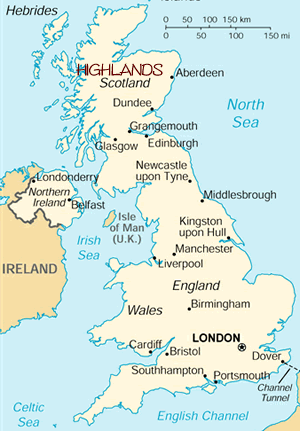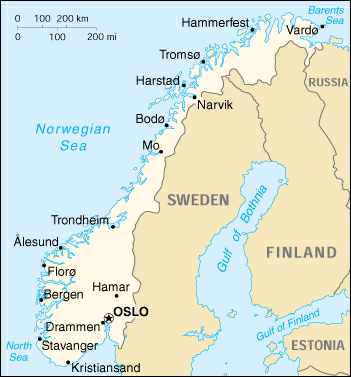A summary of land ownership and deer management practices in Scotland and Norway
Dr. Duncan Halley
Norwegian Institute for Nature Research
March 13.2002
Scotland
 In the Highland areas of Scotland land ownership is dominated by very
large, privately owned estates managed mainly for sport hunting. The
Highland area of Scotland is about half the area of Hokkaido. Of this,
50% is owned by fewer than 100 people. The largest estate is 4680 km2.
Most owners live in southern England or are foreign nationals. Land
is bought and sold without any restrictions. Involvement of the local
community in hunting, in game management, or in land ownership is usually
low or none. Few estates are profitable as presently managed, most requiring
large inflows of money from owners, whose wealth is generated elsewhere.
In the Highland areas of Scotland land ownership is dominated by very
large, privately owned estates managed mainly for sport hunting. The
Highland area of Scotland is about half the area of Hokkaido. Of this,
50% is owned by fewer than 100 people. The largest estate is 4680 km2.
Most owners live in southern England or are foreign nationals. Land
is bought and sold without any restrictions. Involvement of the local
community in hunting, in game management, or in land ownership is usually
low or none. Few estates are profitable as presently managed, most requiring
large inflows of money from owners, whose wealth is generated elsewhere.
Deer management in Scotland has been dominated by the
concept of game animals as the sole property of the landowner. The management
of populations, hunting levels, and use or sale of hunting rights are
determined by the landowner. On most estates, red deer management is
conducted traditionally with little or no scientific input. Hunting
is for trophies; male deer are the main target, so that the ratio of
males to females is usually around 1:2 or higher.
Monitoring of deer populations is undertaken by the Red Deer Commission,
using ground and helicopter counts. Government policy since the 1970s,
both through the Red Deer Commission and Scottish Natural Heritage (the
environmental regulator), and based on abundant scientific evidence,
has been that red deer populations are too high and need to be greatly
reduced.
In theory, the RDC, a government body, can impose a cull but it has never done so, relying on a policy of influencing landowners through consultation, persuasion, and voluntary agreements. The effectiveness of this approach has been questioned, with the RDC itself stating (2000) "The results of open-range red deer counts are disappointing in that several key areas show that red deer stocks have continued to rise." The population of Red Deer is now (2002) over 350,000 (double the 1960 population), and increasing.
This rise has occurred despite the view of SNH, RDC and ecologists that the population has been unsustainably high for at least 150 years and this has caused real and serious damage to the environment, principally through being a main cause of the complete lack of forest regeneration in most of the Highlands. NGOs are highly critical of the present management of red deer. The clear failure to reduce deer numbers, combined with recent political changes in Scotland (the establishment of a Scottish Parliament responsible for land and environment), mean that the current management regime seems to be no longer politically viable.
Land Reform in Scotland, centering on issues of lack of local control, over-concentration of ownership, and the environment is an important political issue. New laws aimed at Land Reform are now (March 2002) being debated in the new Scottish Parliament, and the Scottish Government's Land Reform Action Plan includes "a review of the need for stronger enforcement of deer control measures, to be complete by end 2002".
Deer management practices in Scotland seem to be set to change radically over the next decade.
 Norway
Norway
In contrast, in Norway deer management is much more complex and is community
based. Land ownership in Norway is dispersed, with a much higher rural
population of small farmers than in Scotland, and who own their own
land. These properties usually include a small cultivated area and a
much larger area of wooded hills and mountains, often with a large area
of mountain land in addition, owned jointly with other local farmers.
Hunting forms one of the most important recreational, economic, and
social institutions and is central to the way of life of the farming
community.
The principle economic feature of hunting in Norway is that hunting rights belong to the landowner. He may use them himself or sell them as he wishes. As a result, farming communities have a close integration with non-farmed land in their area, and a direct interest in the management of game animal populations.
However, the number of animals which can be hunted of any species (including red deer, moose, roe deer, and reindeer), is regulated at local and at national level. The local level of control is the township, through a "game committee". Game committees are selected by the township authorities, usually from local landowners and hunters. A main activity of the committees is to define "hunting areas" and to set hunting quotas for each. A larger landowner may be a hunting area by himself; smaller landowners are grouped by mutual consent. A specific number of animals of each species which can be shot is then set for each area by the game committee, for example "4 male and 4 female moose, 3 male and 2 female red deer".
These quotas are then reported to the Directorate for Nature Management, a government body, which has the right to either reduce quotas if it believes they are too high, or impose a cull if they are too low. This right has been used on a number of occasions. The DN is concerned with maintaining the game resource on a national scale at sustainable levels, without causing environmental damage and while minimising unacceptable damage to agriculture. As game is itself an economic asset, farmers tolerate greater levels of damage than is often the case in Scotland or Japan.
In some areas, notably high mountain plateaus and remote
forests in uncultivable areas, much land is owned by the government.
Hunting in these areas is also subject to the Game Committee-DN system.
Hunting rights in these areas are often owned by the local community
although they do not own the land, usually based on traditional hunting
and grazing rights. Where the government owns the hunting rights, they
are often sold preferentially to local hunters; the remainder being
sold commercially.
Hunters in Norway must buy a hunting licence each year. The money from
the resulting モGame Fundモ funds population monitoring and research into
management issues. The fund is managed by the DN, with work carried
out by scientific bodies such as the Norwegian Institute for Nature
Research or universities. The DN also collects hunting data, particularly
on whether quotas have been completely used, from which data on population
trends can be inferred.
Compared to Scotland or to Japan, deer populations are much more closely monitored and managed. The local population has a much greater interest in deer, both as a recreational resource and an important economic resource. Funds generated by hunting licences fund extensive monitoring of and research into deer populations. The management system is stable and the level of conflict, compared to Japan and Scotland, is low and local. The health of the wider environment is very obviously much superior than is the case in Scotland, an area of otherwise similar landforms and climate, where lack of tree regeneration for centuries, caused by overgrazing, has resulted in an almost treeless landscape and associated long-term problems with erosion and reduced productivity of the land.